Microstructure and Characteristics of the Welded Joint between Ni-Cr Alloys and Copper
Abstract
:1. Introduction
2. Materials and Experiment Details
3. Experimental Results and Discussion
3.1. Microstructure and Phase Composition
3.2. Mechanical Properties
3.3. Electrical and Thermal Conductivity Characteristics of Joints
4. Discussion
5. Conclusions
- 1.
- Using filler wire TIG welding allows for the effective joining of nickel–chromium alloys and copper as dissimilar metals. The joint forms well, with no defects such as pores or cracks on the surface, and the joint strength exceeds 220 MPa, meeting the performance requirements.
- 2.
- There is a mutual transition of alloy elements at the interface on both sides of the fusion zone, and the tensile fracture mode is a plastic fracture with an obvious necking phenomenon during the tensile process.
- 3.
- The results of the joint power-on test showed that the temperature change of the joint reached a stable state after 20 min of power-on, about 114 °C, and the temperature on the low-temperature side was about 92 °C. Compared with the low-temperature side, the temperature of the joint did not increase significantly.
Author Contributions
Funding
Data Availability Statement
Conflicts of Interest
References
- Marya, M. A Brief Review of Challenges & Technologies to Weld Dissimilar Metals in Two Industries: The Upstream Oil & Gas and the Automotive. Mater. Sci. Forum 2008, 580–582, 155–158. [Google Scholar] [CrossRef]
- Karim, M.A.; Park, Y.D. A review on welding of dissimilar metals in car body manufacturing. J. Weld. Join. 2020, 38, 8–23. [Google Scholar] [CrossRef]
- Carlone, P.; Astarita, A. Dissimilar metal welding. Metals 2019, 9, 1206. [Google Scholar] [CrossRef]
- Singh, S.; Kumar, V.; Kumar, S.; Kumar, A. Variant of MIG welding of similar and dissimilar metals: A review. Mater. Today Proc. 2022, 56, 3550–3555. [Google Scholar] [CrossRef]
- Kuryntsev, S. A review: Laser welding of dissimilar materials (Al/Fe, Al/Ti, Al/Cu)—Methods and techniques, microstructure and properties. Materials 2021, 15, 122. [Google Scholar] [CrossRef]
- Zhou, L.; Jiang, Z.; Lei, S.; Yu, M.; Zhao, H. Process study for friction stir lap welding of copper/steel dissimilar metals. Trans. China Weld. Inst. 2019, 40, 22–27. [Google Scholar] [CrossRef]
- Singla, Y.; Joshi, R. Mechanical properties study of copper/stainless steel dissimilar weld joints. Mod. Approaches Mater. Sci. 2020, 2, 271–273. [Google Scholar] [CrossRef]
- Lu, W.; Zhang, Y.; Yu, D.; Sun, D.; Li, H. Research progress on control strategy of intermetallic compounds in welding process of heterogeneous materials. Steel Res. Int. 2022, 93, 2100427. [Google Scholar] [CrossRef]
- Jain, A.; Sonia, P.; Kumari, S.; Pushp, P. Study of intermetallic compound (IMC) formed in welding of steel with magnesium: A review. Mater. Today Proc. 2020, 26, 1159–1166. [Google Scholar] [CrossRef]
- Huang, W.; Wang, H.; Rinker, T.; Tan, W. Investigation of metal mixing in laser keyhole welding of dissimilar metals. Mater. Des. 2020, 195, 109056. [Google Scholar] [CrossRef]
- Zuo, D.; Hu, S.S.; Shen, J.Q.; Xue, Z. Intermediate layer characterization and fracture behavior of laser-welded copper/aluminum metal joints. Mater. Des. 2014, 58, 357–362. [Google Scholar] [CrossRef]
- Zhu, B.; Zhen, L.; Xia, H.; Su, J.; Niu, S.; Wu, L.; Tan, C.; Chen, B. Effect of the scanning path on the nanosecond pulse laser welded Al/Cu lapped joint. Opt. Laser Technol. 2021, 139, 106945. [Google Scholar] [CrossRef]
- Afriansyah, A.A. Dissimilar metal welding using Shielded metal arc welding: A Review. Technol. Rep. Kansai Univ. 2020, 62, 1935–1948. [Google Scholar]
- Xie, Y.; Zhuang, J.; Huang, B.; Chen, Q.; Li, G. Effect of different welding parameters on residual stress and deformation of 20/0Cr18Ni9 dissimilar metal arc-welding joint. J. Adhes. Sci. Technol. 2020, 34, 1628–1652. [Google Scholar] [CrossRef]
- Cheng, Z.; Huang, J.; Ye, Z.; Chen, Y.; Yang, J.; Chen, S. Microstructures and mechanical properties of copper-stainless steel butt-welded joints by MIG-TIG double-sided arc welding. J. Mater. Process. Technol. 2019, 265, 87–98. [Google Scholar] [CrossRef]
- Li, Y.; Fan, D.; Li, Y.-P.; Huang, J.-K.; Yu, X.-Q. Effect of ultrasonic power on microstructural and mechanical properties of Al/Cu plasma arc welding–brazing joints. J. Mater. Eng. Perform. 2023, 32, 5365–5374. [Google Scholar] [CrossRef]
- Wang, Y.; Yu, C.; Lu, H.; Chen, J. Research status and future perspectives on ultrasonic arc welding technique. J. Manuf. Process. 2020, 58, 936–954. [Google Scholar] [CrossRef]
- Diab, J.; Dames, E.; Rohani, V.; Wyse, E.; Fulcheri, L. Review of DC and AC Arc Plasma at High Pressures Above Atmospheric Pressure. Plasma Chem. Plasma Process. 2024, 44, 687–720. [Google Scholar] [CrossRef]
- Sadeghian, A.; Iqbal, N. A review on dissimilar laser welding of steel-copper, steel-aluminum, aluminum-copper, and steel-nickel for electric vehicle battery manufacturing. Opt. Laser Technol. 2022, 146, 107595. [Google Scholar] [CrossRef]
- Isa, M.S.M.; Moghadasi, K.; Ariffin, M.A.; Raja, S.; bin Muhamad, M.R.; Yusof, F.; Jamaludin, M.F.; bin Yusoff, N.; bin Ab Karim, M.S. Recent research progress in friction stir welding of aluminium and copper dissimilar joint: A review. J. Mater. Res. Technol. 2021, 15, 2735–2780. [Google Scholar] [CrossRef]
- Ma, B.; Gao, X.; Huang, Y.; Gao, P.P.; Zhang, Y. A review of laser welding for aluminium and copper dissimilar metals. Opt. Laser Technol. 2023, 167, 109721. [Google Scholar] [CrossRef]
- Otsuka, K.; Ren, X. Martensitic transformations in nonferrous shape memory alloys. Mater. Sci. Eng. A 1999, 273, 89–105. [Google Scholar] [CrossRef]
- Xie, Y.; Huang, J.; Su, J.; Luo, Y.; Du, H.; Fan, D. Effect of nickel interlayer on laser welding of copper/titanium dissimilar metal joint. J. Mater. Res. Technol. 2023, 27, 4416–4429. [Google Scholar] [CrossRef]
- Chakrabarti, D.J.; Laughlin, D.E. The Cr-Cu (chromium-copper) system. Bull. Alloy Phase Diagr. 1984, 5, 59–68. [Google Scholar] [CrossRef]
- Bogdanov, A.I.; Kulevich, V.P.; Shmorgun, V.G. Microstructure evolution and growth of interfacial intermetallic compounds in NiCr/Ti alloy laminated composite after explosive welding and heat treatment. Metals 2023, 13, 1417. [Google Scholar] [CrossRef]
- Ioannidou, D.; Kaldellis, A.; Makris, N.; Deligiannis, S.; Skarvelis, P.; Tsakiridis, P.E. Copper contribution on microstructure and mechanical properties of dissimilar gas tungsten arc welded Ti–6Al–4V to Inconel® X-750. Weld. World 2024, 68, 2577–2588. [Google Scholar] [CrossRef]
- Xin, J.; Zhang, H.; Sun, W.; Huang, C.; Wang, S.; Wei, J.; Wang, W.; Fang, Z.; Wu, D.; Li, L. The microstructures and mechanical properties of dissimilar laser welding of copper and 316L stainless steel with Ni interlayer. Cryogenics 2021, 118, 103344. [Google Scholar] [CrossRef]
- Yang, K.; Wang, Y.; Guo, M.; Wang, H.; Mo, Y.; Dong, X.; Lou, H. Recent development of advanced precipitation-strengthened Cu alloys with high strength and conductivity: A review. Prog. Mater. Sci. 2023, 138, 101141. [Google Scholar] [CrossRef]
- Kossman, S.; Coorevits, T.; Iost, A.; Chicot, D. A new approach of the Oliver and Pharr model to fit the unloading curve from instrumented indentation testing. J. Mater. Res. 2017, 32, 2230–2240. [Google Scholar] [CrossRef]
- Dugdale, J.S. The Electrical Properties of Metals and Alloys; Courier Dover Publications: Mineola, NY, USA, 2016. [Google Scholar]
- Kah, P.; Shrestha, M.; Martikainen, J. Trends in joining dissimilar metals by welding. Appl. Mech. Mater. 2014, 440, 269–276. [Google Scholar] [CrossRef]
- Baghel, P.K. Effect of SMAW process parameters on similar and dissimilar metal welds: An overview. Heliyon 2022, 8, e12161. [Google Scholar] [CrossRef] [PubMed]

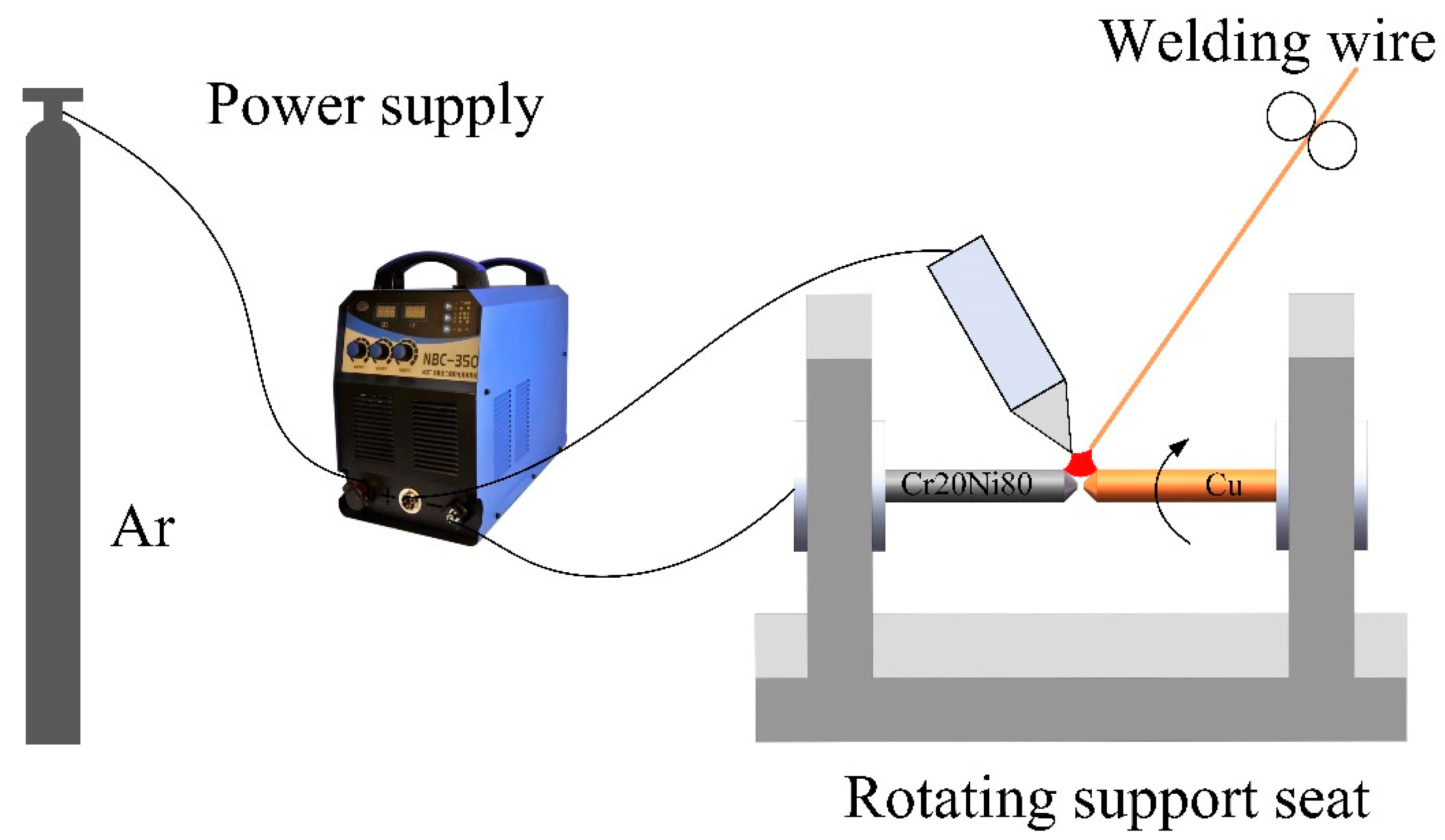




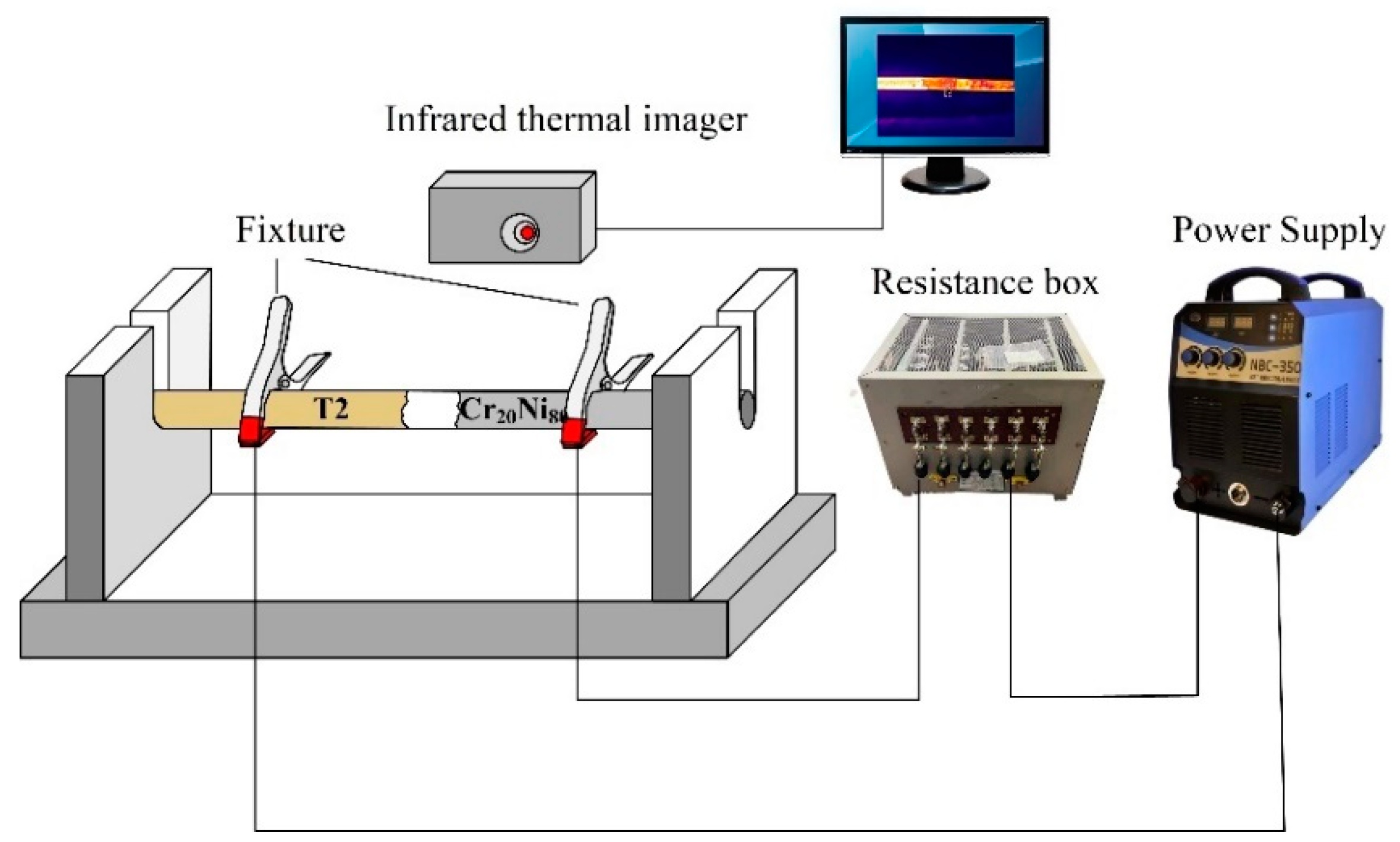



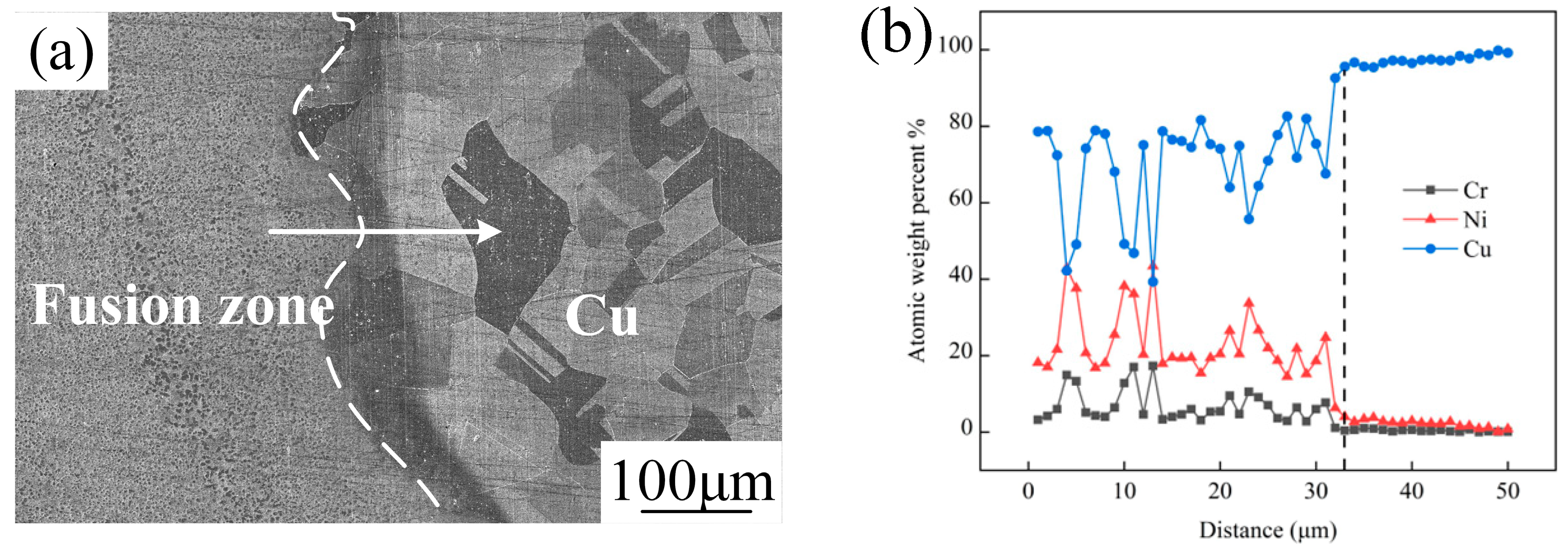

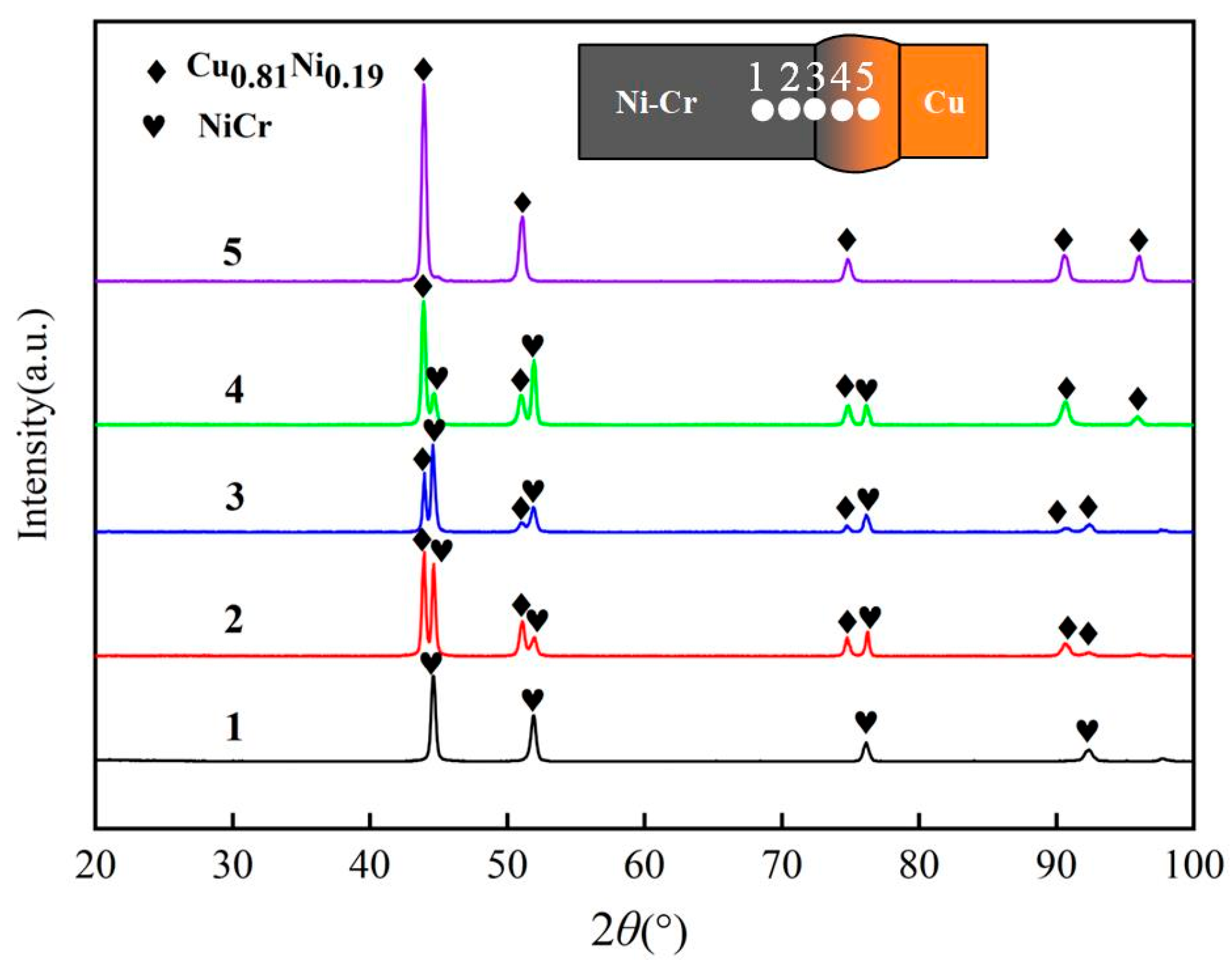

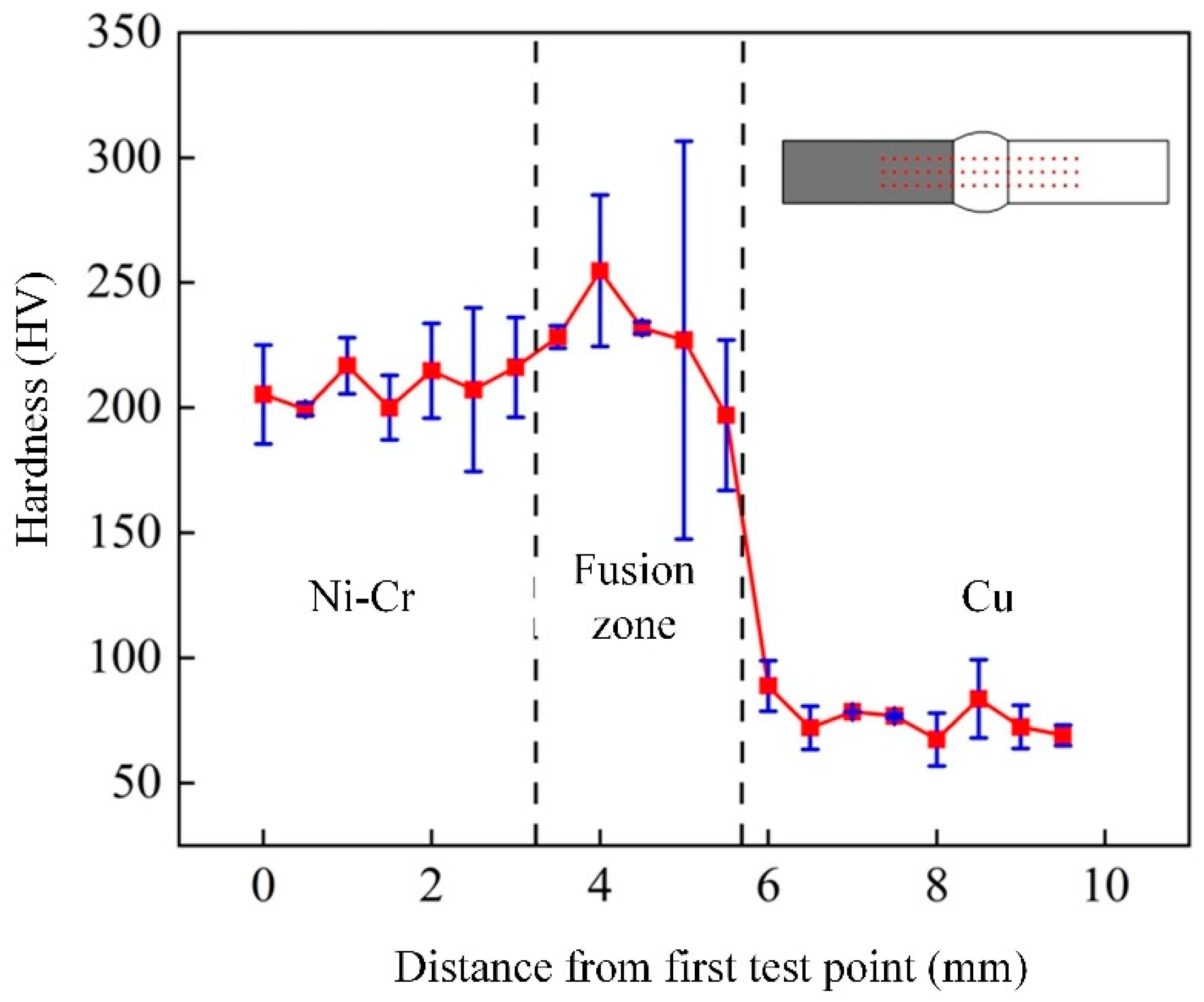


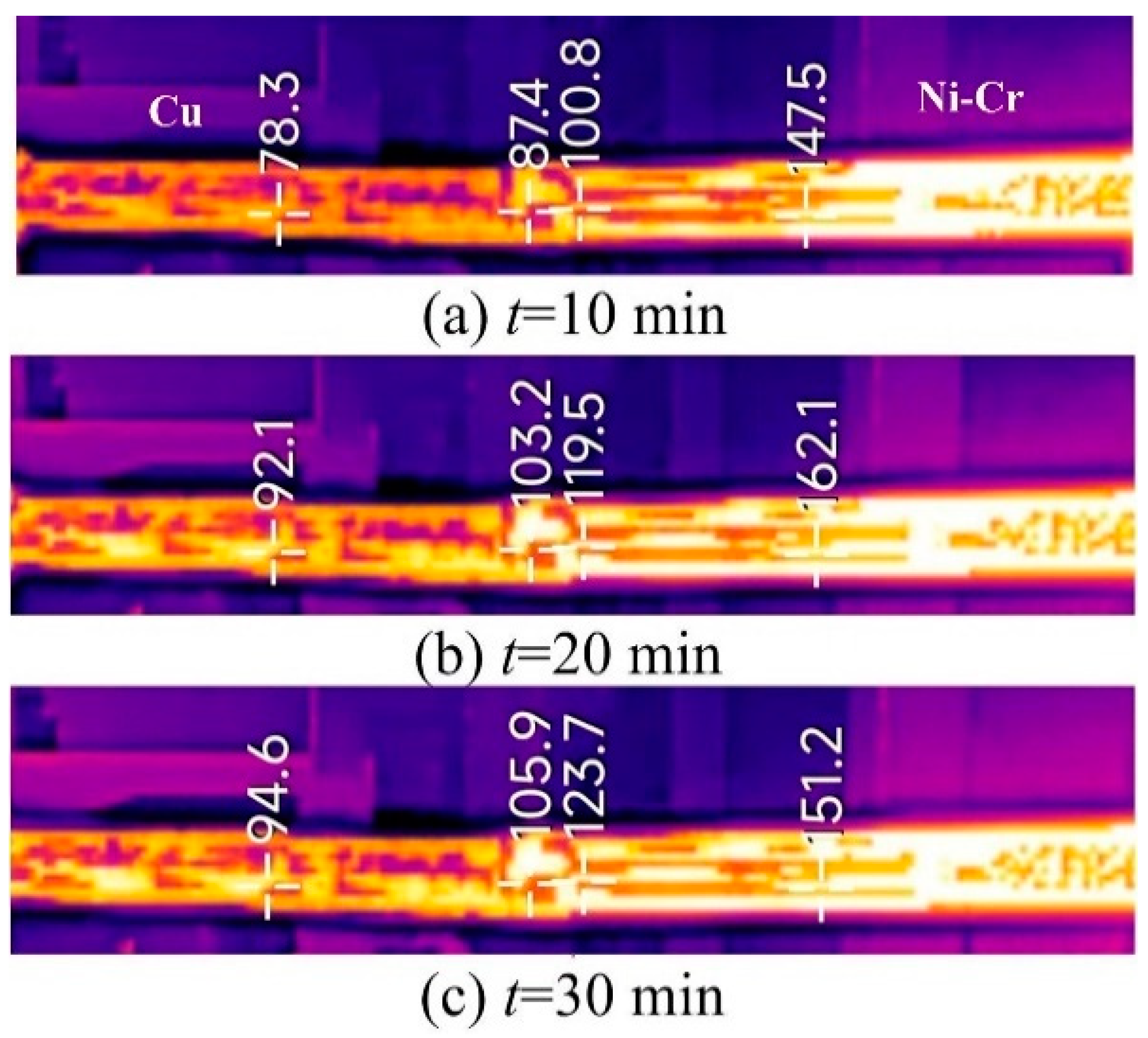



| Material | Cu | Bi | Sb | As | Fe | Pb | S |
|---|---|---|---|---|---|---|---|
| Red copper | ≥99.9 | ≤0.001 | ≤0.002 | ≤0.002 | ≤0.005 | ≤0.005 | ≤0.005 |
| Material | C | Mn | P | S | Si | Fe | Al | Cr | Ni |
|---|---|---|---|---|---|---|---|---|---|
| Cr20Ni80 | ≤0.08 | ≤0.6 | ≤0.02 | ≤0.0015 | 0.75–1.60 | ≤1 | ≤0.5 | 20–23 | Balance |
| Region | Hardness (MPa) | Elastic Modulus (GPa) |
|---|---|---|
| Ni-Cr side | 2232.5 | 266.39 |
| Ni-Cr/Fusion zone interface | 1847.3 | 163.62 |
| Fusion zone | 1473.3 | 157.37 |
| Fusion zone/Cu interface | 1031.6 | 164.86 |
| Cu side | 666.76 | 137.06 |
Disclaimer/Publisher’s Note: The statements, opinions and data contained in all publications are solely those of the individual author(s) and contributor(s) and not of MDPI and/or the editor(s). MDPI and/or the editor(s) disclaim responsibility for any injury to people or property resulting from any ideas, methods, instructions or products referred to in the content. |
© 2024 by the authors. Licensee MDPI, Basel, Switzerland. This article is an open access article distributed under the terms and conditions of the Creative Commons Attribution (CC BY) license (https://creativecommons.org/licenses/by/4.0/).
Share and Cite
Zhang, J.; Zhang, W.; Yu, X.; Xie, H.; Zhou, C.; Song, H.; Huang, J. Microstructure and Characteristics of the Welded Joint between Ni-Cr Alloys and Copper. Metals 2024, 14, 1105. https://doi.org/10.3390/met14101105
Zhang J, Zhang W, Yu X, Xie H, Zhou C, Song H, Huang J. Microstructure and Characteristics of the Welded Joint between Ni-Cr Alloys and Copper. Metals. 2024; 14(10):1105. https://doi.org/10.3390/met14101105
Chicago/Turabian StyleZhang, Jingang, Wanpeng Zhang, Xiaoquan Yu, Hang Xie, Chao Zhou, Hongbing Song, and Jiankang Huang. 2024. "Microstructure and Characteristics of the Welded Joint between Ni-Cr Alloys and Copper" Metals 14, no. 10: 1105. https://doi.org/10.3390/met14101105






